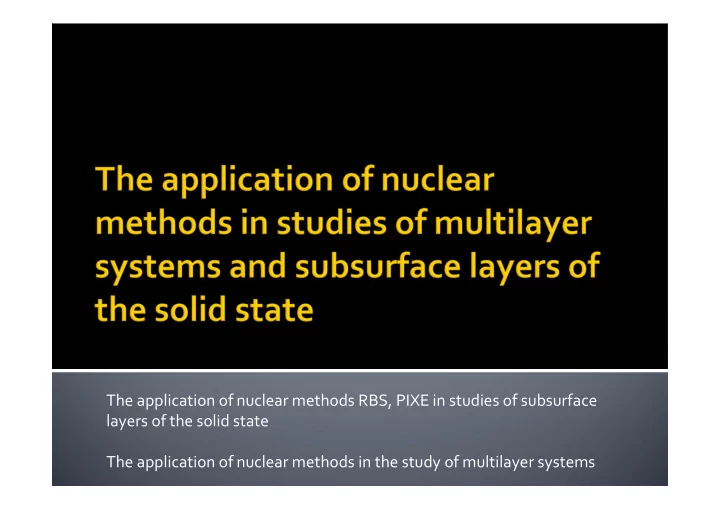

The application of nuclear methods RBS, PIXE in studies of subsurface layers of the solid state The application of nuclear methods in the study of multilayer systems
Michalina Choszcz Faculty of Technical Physics and Mathematics Gdańsk University of Technology Maciej Mikosza Faculty of Fundamental Problems of Technics Wrocław University of Technology SUPERVISOR : dr Mirosław Kulik Frank Laboratory of Neutron Physics JINR Dubna
Van de Graaff accelerator Rutherford Backscattering Spectrometry (RBS) Elastic Recoil Detection (ERD) Nuclear ReactionsAnalysis (NRA)
http://neutron.ujf.cas.cz/vdg/graaff-principle.html
https://www.hzdr.de/db/Cms?pOid=29856&pNid=3537
Θ – scattering angle http://gui-matrixlab.blogspot.ru/2012/10/rbs-rutherford-backscattering.html � � = � � + � � � � k = � � � � = � � � � + � � � � � �
Partial RBS spectrum: minerva.union.edu/labrakes/RBS%20Physics%20300%20S12.ppt
simulated Yield= σ(θ,E) D Nt dΩ experimental 1100 σ(θ,E) – Rutherford cross-section E =2297.00keV 1000 D – number of incident ions 900 Nt – concentration of target =135 O surface 800 nucleons Yield(counts) 700 Si substrate dΩ – solid angle of the detector 600 Ti surface and layers 500 400 300 Si layers 200 100 0 200 300 400 500 600 700 800 900 1000 channel E(channel)=offset+energy per channel*channel
simulated experimental 16000 E = 2297.00keV 14000 ° C surface O surface We find small amount of Cu atoms 12000 ° Yield(counts) 10000 Si substrate 8000 simulated Al surface experimental 500 6000 400 4000 Cu surface 2000 Yield(counts) 300 0 Cu surface 200 500 1000 1500 2000 2500 Energy (keV) 100 0 1700 1750 1800 1850 1900 Energy (keV)
https://www.hzdr.de/db/Cms?pOid=29856&pNid=3537
http://america.pink/elastic-recoil-detection_1398816.html
simulated experimental 5000 E 2297.00 keV 4500 Ag ° 4000 ° 3500 3000 Yield(counts) simulated 2500 experimental 200 In surface H surface and layers 2000 E = 2297.00 keV O surface and layer ° 1500 Si substrate ° 1000 150 500 Yield (counts) 0 500 1000 1500 2000 2500 100 Energy (keV) 50 D 0 0 200 400 600 800 1000 1200 Energy (keV)
https://www.hzdr.de/db/Cms?pOid=29856&pNid=3537
simulated Depth Profile: experimental O surface 25000 E keV ° 20000 ° Yield (counts) 15000 10000 Si substrate and layers Ti layers and surface 5000 0 1000 1500 2000 2500 Energy(keV) All the simulations were performed using SIMNRA developed by Matej Mayer
Using RBS we can determine concentration and depth distribution of elements in the material We can use ERD to obtain concentration of H or D in the material We can use NRA to detect light elments
Recommend
More recommend